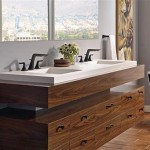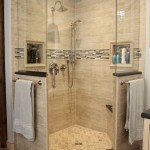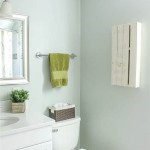Bathroom With Drain In Floor
Bathrooms with floor drains offer a range of benefits, from enhanced accessibility to simplified cleaning routines. Understanding the different types of floor drains, their installation process, and maintenance requirements is crucial for homeowners considering this design feature.
Floor drains serve as a central point for water drainage, eliminating the need for a raised shower base or curb. This creates a seamless transition between the shower area and the rest of the bathroom floor, enhancing the visual appeal and creating a more spacious feel. This design is particularly beneficial for individuals with mobility limitations, as it eliminates a potential tripping hazard.
Several types of floor drains are available, each designed with specific features and benefits. Linear drains, characterized by their elongated shape, offer a sleek, modern aesthetic and efficient drainage. Point drains, the more traditional option, are circular or square and are typically installed in the center of the shower area. Another option is the trench drain, a longer, narrower version of the linear drain offering increased drainage capacity. Choosing the right type of drain depends on factors such as bathroom size, design preferences, and the existing plumbing infrastructure.
The installation process for a bathroom floor drain involves careful planning and execution to ensure proper functionality and prevent water damage. The process typically begins with rough-in plumbing, where the drainpipes and necessary connections are installed beneath the floor. The subfloor must be properly sloped towards the drain to facilitate efficient water flow. This typically involves creating a gradient of approximately ¼ inch per foot. A waterproofing membrane is then applied over the sloped subfloor to prevent water seepage. Finally, the chosen flooring material, such as tile or stone, is installed over the membrane, completing the process.
The choice of flooring material plays a vital role in both the aesthetics and functionality of a bathroom with a floor drain. Non-porous materials like porcelain or ceramic tile are highly recommended due to their water resistance and durability. Natural stone, while aesthetically pleasing, requires regular sealing to prevent water absorption and staining. Regardless of the chosen material, ensuring a smooth, even surface with proper sloping towards the drain is crucial for effective water drainage.
Maintaining a bathroom floor drain is essential for preventing clogs and unpleasant odors. Regular cleaning involves removing debris such as hair and soap scum that can accumulate around the drain opening. Periodically flushing the drain with hot water can help prevent buildup and maintain proper drainage. Using a drain strainer can also help to catch debris before it enters the drain. If a clog occurs, a plunger or a drain snake can be used to clear the blockage. For more persistent clogs, consulting a professional plumber is recommended.
Proper ventilation is crucial in bathrooms with floor drains to prevent the buildup of moisture and mildew. Adequate ventilation can be achieved through a combination of exhaust fans and open windows. The exhaust fan should be sized appropriately for the bathroom's square footage and should be run during and after showers to remove excess moisture. Ensuring proper airflow helps to dry the floor quickly, minimizing the risk of mold and mildew growth.
Considering local building codes and regulations is paramount before embarking on a bathroom renovation involving a floor drain. These codes often dictate specific requirements for drain placement, pipe sizing, and ventilation. Obtaining the necessary permits and inspections ensures compliance with local regulations and helps prevent potential problems down the line. Consulting with a qualified contractor experienced in bathroom renovations is highly recommended to ensure adherence to all applicable codes and regulations.
While bathrooms with floor drains offer numerous advantages, they also present some potential drawbacks. One concern is the potential for water to splash outside the shower area if the sloping of the floor is not properly executed. This can lead to slippery surfaces and potential water damage to adjacent areas. Another consideration is the complexity of the installation process, which typically requires the expertise of a qualified plumber and tiler. The initial cost of installation can also be higher compared to traditional shower installations.
Despite these potential drawbacks, the benefits of a bathroom with a floor drain, especially in terms of accessibility and aesthetics, often outweigh the challenges. With careful planning, professional installation, and regular maintenance, a bathroom with a floor drain can provide a stylish and functional addition to any home.

Modern Bathroom Floor Drain Design Ideas Engineering Discoveries

Demystifying Floor Drains 10 Questions Everyone Asks

Floor Drains And Shower Channels

45 Lovely Shower Floor Drain Design Ideas Engineering Discoveries

Shower Floor Ideas Which Li Drain To Choose Sebring Design Build

Invisible Stainless Steel Rectangle Floor Drain Long Row For Bathroom

Infinity Drain With Slab Floor Contemporary Bathroom New York By Houzz Ie

Floor Drain Wikipedia

Reliable Bathroom Floor Drains For Optimal Water Flow Browse Today

Interbath Brushed Nickel 6 Inch Square Invisible Shower Floor Drain Detachable Bathroom Itbfd66ns B The Home







